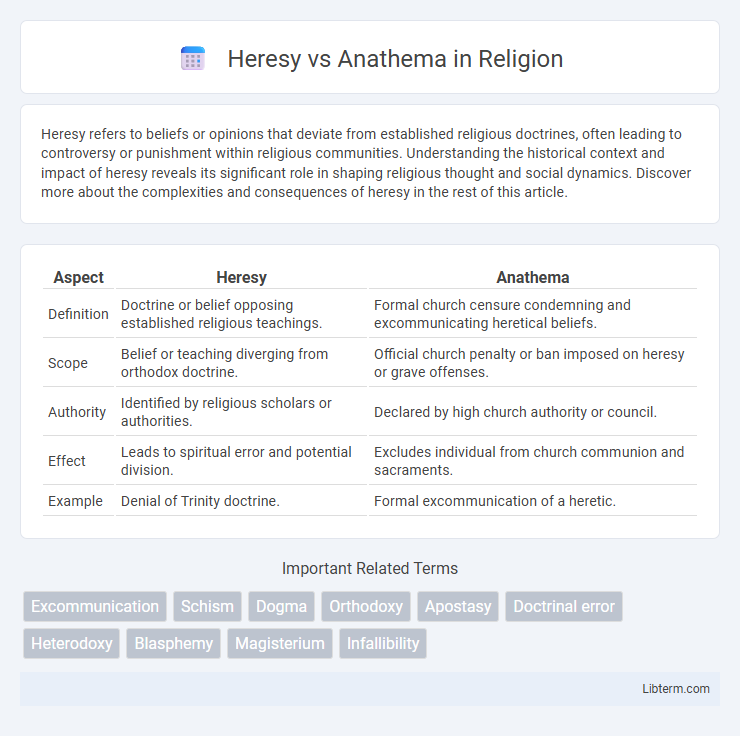Heresy refers to beliefs or opinions that deviate from established religious doctrines, often leading to controversy or punishment within religious communities. Understanding the historical context and impact of heresy reveals its significant role in shaping religious thought and social dynamics. Discover more about the complexities and consequences of heresy in the rest of this article.
Table of Comparison
| Aspect | Heresy | Anathema |
|---|---|---|
| Definition | Doctrine or belief opposing established religious teachings. | Formal church censure condemning and excommunicating heretical beliefs. |
| Scope | Belief or teaching diverging from orthodox doctrine. | Official church penalty or ban imposed on heresy or grave offenses. |
| Authority | Identified by religious scholars or authorities. | Declared by high church authority or council. |
| Effect | Leads to spiritual error and potential division. | Excludes individual from church communion and sacraments. |
| Example | Denial of Trinity doctrine. | Formal excommunication of a heretic. |
Defining Heresy: Origins and Meaning
Heresy originates from the Greek word "hairesis," meaning choice or sect, traditionally defining beliefs or opinions that deviate from established orthodox doctrines, especially in religious contexts. It represents teachings that contradict core dogmas set forth by religious authorities, often leading to condemnation or exclusion from the faith community. Understanding heresy is crucial in theological studies, as it highlights conflicts between orthodox beliefs and divergent interpretations throughout history.
Understanding Anathema: Historical Context
Anathema historically refers to a formal ecclesiastical ban or curse pronounced by church authorities, distinct from heresy, which denotes belief or doctrine contrary to established dogma. In early Christianity, anathema indicated excommunication combined with condemnation, used to preserve doctrinal purity and maintain church unity. This severe sanction was significant in councils, such as the Council of Nicaea, where it marked definitive rejection of heretical teachings.
Etymological Roots: Heresy vs Anathema
Heresy originates from the Greek word "hairesis," meaning "choice" or "sect," emphasizing a deliberate deviation from established religious doctrines. Anathema derives from the Greek "anathema," signifying "a thing devoted" or "accursed," often used to denote formal ecclesiastical condemnation or excommunication. Understanding these etymological roots clarifies how heresy implies ideological divergence while anathema conveys authoritative denunciation and exclusion within religious contexts.
Heresy in Major World Religions
Heresy refers to beliefs or practices that deviate significantly from established doctrines within major world religions such as Christianity, Islam, and Judaism, often resulting in spiritual and social consequences for adherents. In Christianity, heresy includes denial of core tenets like the divinity of Jesus, leading to excommunication or condemnation by church authorities. Islamic heresy, or bid'ah, involves innovations in religious practice that contradict the Quran and Hadith, while in Judaism, heretical views challenge the Torah's authority, impacting communal religious identity.
Anathema in Religious Doctrine
Anathema in religious doctrine refers to a formal ecclesiastical ban or excommunication pronounced against a person or doctrine deemed heretical or severely deviant from orthodox beliefs. Unlike heresy, which represents the holding of beliefs contrary to established doctrine, anathema implies a definitive cursing and expulsion from the faith community, often accompanied by ritual condemnation. The term carries significant theological weight, symbolizing both spiritual severance and social ostracism within Christian traditions, especially in Catholic and Orthodox churches.
Theological Implications of Heresy
Heresy signifies the persistent deviation from established doctrinal teachings within Christianity, challenging the core tenets of faith and endangering the unity of the Church. Theological implications of heresy involve undermining the integrity of divine revelation and distorting the interpretation of Scripture, leading to spiritual confusion among believers. Anathema, by contrast, is a formal ecclesiastical censure that excommunicates and condemns heretical beliefs, reinforcing the boundaries of orthodox doctrine.
Social and Cultural Impact of Anathema
Anathema, as a formal ecclesiastical censure, profoundly influenced social cohesion by ostracizing individuals and reinforcing religious orthodoxy within communities. This exclusion often extended beyond spiritual condemnation into social isolation, affecting familial ties and economic interactions. The cultural impact of anathema manifested in art, literature, and traditions that emphasized conformity and the consequences of deviating from sanctioned beliefs.
Key Differences Between Heresy and Anathema
Heresy refers to the holding of beliefs that deviate from established orthodox doctrines, often leading to doctrinal errors within a religious context. Anathema is a formal ecclesiastical condemnation or excommunication, signifying a severe penalty imposed on individuals or teachings deemed dangerously heretical. The key difference lies in heresy being the erroneous belief itself, while anathema is the authoritative act of denouncing and excluding those beliefs or their proponents from the religious community.
Famous Historical Cases: Heresy vs Anathema
Heresy and anathema have shaped religious history through pivotal cases such as the trial of Galileo Galilei, condemned for heliocentric teachings deemed heretical, and the Council of Trent's anathematization of Protestant doctrines. The condemnation of Jan Hus as a heretic led to his execution and intensified reformist movements, while the anathema pronounced by the Catholic Church against Martin Luther solidified the East-West schism. These historical instances illustrate how heresy involves deviation from core beliefs, whereas anathema signifies formal ecclesiastical excommunication and denunciation.
Modern Perspectives on Heresy and Anathema
Modern perspectives on heresy and anathema emphasize the evolving understanding of doctrinal deviations within contemporary religious contexts. Heresy is increasingly viewed as a challenge to traditional theological boundaries, while anathema represents formal ecclesiastical condemnation with lasting spiritual consequences. Religious scholars analyze these concepts through historical, sociological, and interfaith lenses, highlighting shifts in authority, tolerance, and interpretation in global Christianity.
Heresy Infographic

 libterm.com
libterm.com